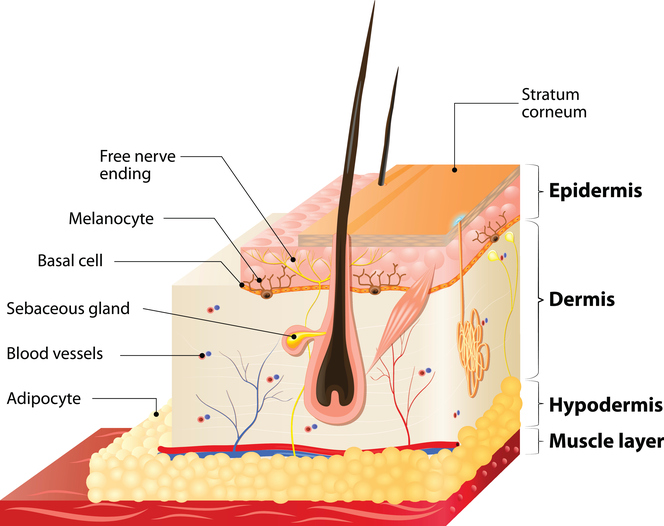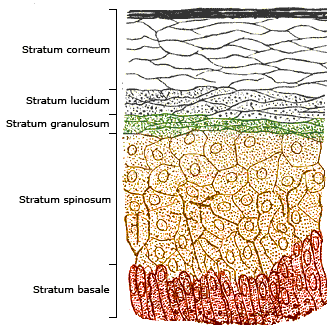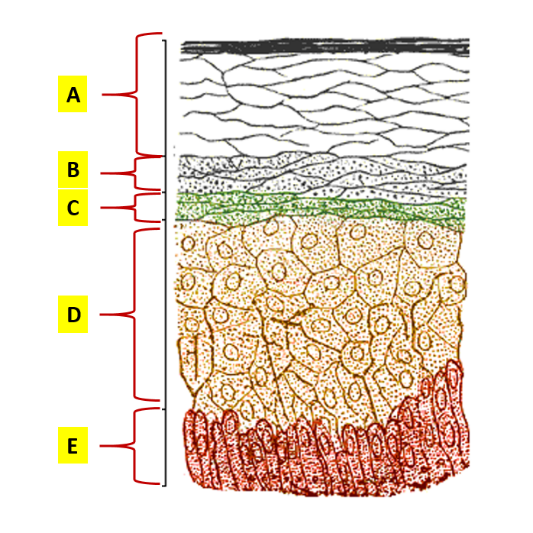Layers and Cells of the Skin
The skin is composed of 3 main layers:
- epidermis,
- dermis, and
- hypodermis.

Epidermis
The epidermis is the outside layer of skin that is made of closely packed epithelial cells and is divided into 4-5 sublayers. Thick skin (such a soles of the feet) has 5 layers while thin skin (such as the face) has 4 layers. The epidermis contains cells for protection, pigment production, and immunity.
There are 5 sublayers in the epidermis.
- Stratum Corneum – superficial layer containing keratin-packed dead cells and the cells that produce keratin a protein that provides strength, flexibility, and toughness to the skin .
- Stratum Lucidum – this layer only present in thick skin
- Stratum Granulosum – keratinocytes lose their nuclei as they migrate up to this layer
- Stratum Spinosum – contains Langerhans cells and keratinocytes
- Stratum Basale – deepest layer where cell division occurs producing new cells that migrate up to the surface and are sloughed off; a process taking about 4-6 weeks. Merkel cells cells of the epidermis involved in the function of touch sensations , melanocytes melanin-producing cells located in the bottom layer of the skin's epidermis , and keratinocytes cells producing the protein keratin are found in this layer.
The life cycle of keratinocytes, which makes up most of the cell types in the skin, lasts 4-6 weeks. New keratinocytes form at this layer from dividing stem cells and migrate to the top of the epidermis. They increase keratin production and eventually stop dividing.
The top layer of the epidermis consists of tightly packed dead keratinocytes that have lost their cell nucleus and other organelles. The skin owes most of its tough, waterproof barrier function to this top layer.
These dead cells slough off easily and are replaced every 4 to 6 weeks by new keratinocytes that have migrated from the bottom of the epidermis to the top.
Below is a drawing of the 5 sublayers of the epidermis and a microscopic image of the layers.


Dermis
The dermis is made of dense, irregular connective tissue and located directly beneath the epidermis. It contains blood vessels, nerve endings, hair follicles, and sweat and oil glands. Its function is to supply the epidermis with oxygen and nutrients from blood and to regulate body temperature. Oil glands within the dermis secrete lipids that travel through the pores to the surface to lubricate and waterproof the skin.
There are 2 sublayers of the dermis:
- Papillary – layer just beneath the epidermis and supplies nutrients to cells in the epidermis. Fingerprints are a result of the ridges in this layer.
- Reticular – thickest layer of the dermis and made of collagen fibers protein of the connective tissue providing strength and cushioning produced by cells called fibroblasts a cell in connective tissue that produces collagen and other fibers .
Hypodermis
The hypodermis is composed of loose, connective tissue and fatty tissue. This layer insulates the body and connects the skin to an underlying surface.
Check Your Understanding
1. The skin provides the outer covering for your body. What is the skin's function?
- to provide a barrier against pathogens
- to help excrete wastes
- to produce vitamin D
- to protect our body from dehydration
- All of the above
2. A layer of dead cells gives your skin most of its tough, waterproof barrier function. True or False?
3. The skin plays a role in producing vitamin D through UV energy. If children have a prolonged deficiency of vitamin D, they can develop a bone softening disease called ______.
4. Which of the 3 layers of the skin contains blood vessels, oil glands, and hair follicles?
5. If you were to get a splinter and bacteria entered your cut, which cell of the skin would engulf the bacteria?
6. Identify each layer of the epidermis in the image below.

A is the stratum ___________.
B is the stratum ___________.
C is the stratum ___________.
D is the stratum ___________.
E is the stratum ___________.
7. Which layer of the epidermis is where new skin cells are made through cell division?
8. Which layer of the epidermis contains keratin-packed dead cells?
9. If skin stimulated collagen production, which cell would be working?
- Langerhans cell
- Keratinocyte
- Melanocyte
- Merkel cell
- Fibroblast
